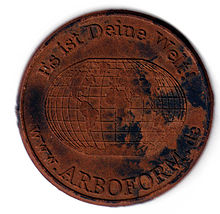Arboform
Arboform ( Latin arbor , tree ' ) is a biomaterial developed in 1998 that is mainly made from the wood components lignin and cellulose . The name "Arboform" (like the names of similar products such as Fasalex and Werzalit) is a registered trademark. The material is also known as "liquid wood" or "liquid wood" in English .
development
Arboform was developed in 1998 by Helmut Nägele and Jürgen Pfitzer as part of a partnership between the Fraunhofer Institute for Chemical Technology (ICT) and its offshoot Tecnaro Society for the Industrial Application of Renewable Raw Materials mbH .
Manufacturing
Arboform is based on lignin, one of the main components of wood, which is produced as a waste or by- product in paper production. Lignin consists of highly complex macromolecules ( polymers ). The so-called 'Kraft lignin', which is produced in the sulphate process in paper production, must first be cleaned in a complex process. Natural fibers such as cellulose, flax or hemp as well as natural additives are added to the brown lignin powder . The fiber mixture is pressed into a pea-sized granulate at 110-170 ° C and 150 MPa .
properties
Arboform from 110 to 170 ° C, at a pressure of 1000 bar , thermoplastic and then arbitrarily deformable. It is more resistant to pressure than wood . The mechanical properties depend on the type and amount of reinforcement fibers used. The modulus of elasticity is according to the manufacturer up to 7,000 MPa, the maximum tensile strength of about 40 MPa. The manufacturer specifies the maximum impact strength as 95 kJ / m 2 .
Arboform is brown in color, similar to wood. It can be artificially colored, but not made in white or transparent.
Processing and Applications
The material can be processed with established plastic processing forms, in particular by injection molding , extrusion , pressing, deep drawing and blow molding .
It is used in the manufacture of semi-finished products , panels and molded parts. It is a component of loudspeakers, funeral urns, watch cases, toys, furniture, device cases, buttons and circuit boards and is sometimes used in series production.
The raw material is used by the manufacturing company for the production of a composite material comparable to wood-plastic composite and for a mixture with other proportions of renewable raw materials.
Web links
- Christoph Herwartz: Completely without petroleum: Like plastic - only better , Stern magazine , August 25, 2008
- Video: Liquid wood: high-tech for the future - world of wonders
Individual evidence
- ↑ a b Andreas Kalweit, Christof Paul, Sascha Peters, Reiner Wallbaum: Handbook for Technical Product Design, Material and Manufacturing, decision-making bases for designers and engineers . Springer-Verlag, 2011, ISBN 978-3-642-02642-3 , pp. 200 ( limited preview in Google Book Search).
- ↑ a b Sascha Peters: Material revolution Sustainable and multifunctional materials for design and architecture . Walter de Gruyter, 2011, ISBN 978-3-0346-1078-0 , p. 38 ( limited preview in Google Book search).
- ^ Francisco G. Calvo-Flores, José A. Dobado, Joaqu? N Isac-Garc? A, Francisco J. Mart? N-Mart? Nez: Lignin and Lignans as Renewable Raw Materials Chemistry, Technology and Applications . John Wiley & Sons, 2015, ISBN 978-1-118-68351-4 , pp. 264 ( limited preview in Google Book search).
- ^ A b Thomas Q. Hu: Chemical Modification, Properties, and Usage of Lignin . Springer Science & Business Media, 2012, ISBN 978-1-4615-0643-0 , p. 100 ( limited preview in Google Book search).
- ↑ Jutta Geldermann: Plant and energy industry, cost and investment estimate as well as technology assessment of industrial plants . Vahlen, 2014, ISBN 978-3-8006-4789-7 , pp. 62 ( limited preview in Google Book search).
- ^ FA Brockhaus (Firm): The Brockhaus in ten volumes . FA Brockhaus, 2005, p. 250 ( limited preview in Google Book Search).
- ↑ nova-Institut GmbH, (Ed.): "Product catalog natural fiber injection molding", pp. 70–73, ISBN 978-3-9805840-9-8 .
- ↑ a b Wood becomes plastic , article by Beate Brehm in Weser-Kurier of March 23, 2009, p. 22.
